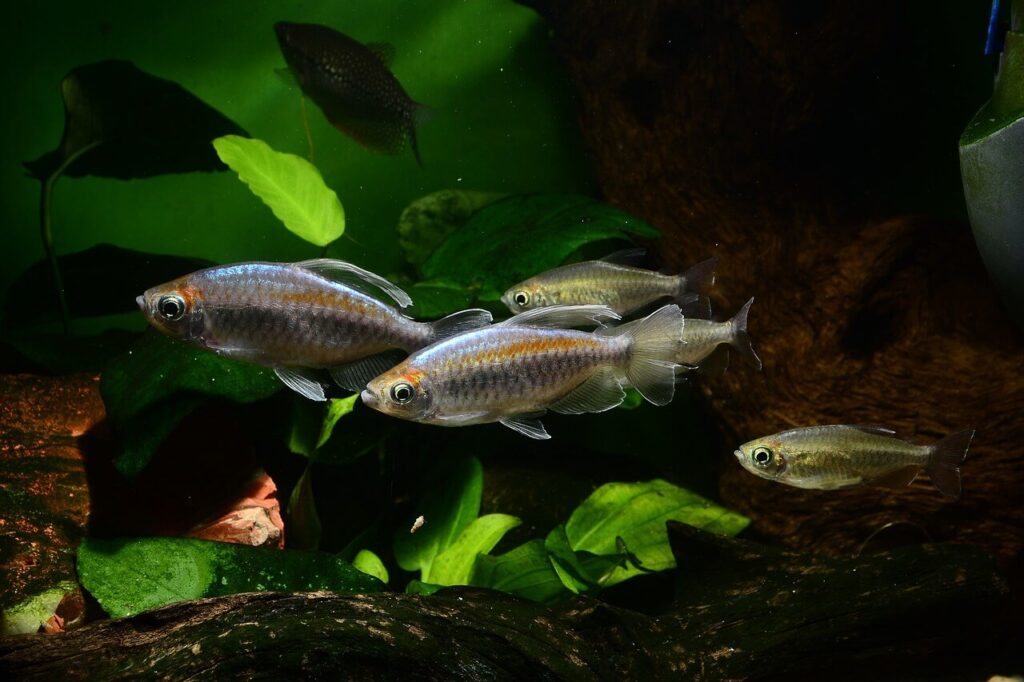Tetra Fish Tank Ammonia levels in a Tetra fish tank are a critical factor in the overall health and well-being of your aquarium’s inhabitants. Tetras, known for their vibrant colors and active behavior, require a stable and balanced environment to thrive. High ammonia levels can be detrimental to their health and may lead to various issues such as stress, illness, and even fatalities. In this comprehensive guide, we’ll explore everything you need to know about Tetra fish tank ammonia levels, how to test and control them, and ensure the optimal tetra fish tank ammonia levels for your aquatic friends.
How to Keep Ammonia Levels Down in Fish Tank Naturally
To naturally reduce tetra fish tank ammonia levels your fish tank, increase the frequency of partial water changes, which dilute ammonia levels. Ensure you’re not overfeeding your fish, as excess uneaten food can contribute to ammonia buildup. Additionally, consider adding live aquatic plants to your tank, as they absorb ammonia as a nutrient for growth. Maintaining a healthy biological filter with beneficial bacteria is crucial, as these bacteria break down ammonia into less harmful substances. Lastly, you can use zeolite-based filter media to temporarily reduce ammonia levels, but this should not replace regular maintenance practices.
Signs of Too Much Ammonia in Fish Tank
Excessive tetra fish tank ammonia levels in a fish tank can manifest in several ways. Common signs include fish gasping for air at the water’s surface, erratic swimming behavior, clamped fins, reduced appetite, and lethargy. You may also observe white cloudy patches on fish gills and skin, which are indicative of ammonia burns. If you notice these symptoms, it’s essential to test and address ammonia levels promptly to prevent further harm to your aquatic pets.
What Causes High Ammonia Levels in Fish Tank
High tetra fish tank ammonia levels in a fish tank can be caused by several factors. Tetra fish tank ammonia levels are affected from overfeeding your fish and allowing uneaten food to decompose is a primary contributor. Inadequate filtration, such as an undersized or poorly maintained filter, can also lead to ammonia buildup. Overcrowding the tank with too many fish can overwhelm the biological filtration capacity and create tetra fish tank ammonia levels. In newly established aquariums, a lack of beneficial bacteria can result in temporary ammonia spikes. Neglecting routine water changes and general tank maintenance can also contribute to elevated ammonia levels. Identifying and addressing these root causes is essential for maintaining a healthy aquarium environment and preventing high tetra fish tank ammonia levels.
| Topic | Summary |
|---|---|
| Signs of Too Much Ammonia in Fish Tank | Watch for gasping fish, erratic swimming, clamped fins, reduced appetite, lethargy, and ammonia burns. |
| How to Remove Ammonia from Fish Tank Naturally | Increase water changes, avoid overfeeding, add live plants, maintain beneficial bacteria, use zeolite-based media. |
| How to Keep Ammonia Levels Down in Fish Tank Naturally | Prevent overfeeding, maintain proper filtration, use live plants, perform regular water changes, supplement with beneficial bacteria. |
| How to Keep Ammonia Levels Down in Fish Tank at Home | Test regularly, practice responsible feeding, maintain filtration, add live plants, perform water changes, monitor fish health. |
| Fish Tank Ammonia Remover | Options include beneficial bacteria supplements, zeolite-based media, water changes, and activated carbon. |
| What Causes High Ammonia Levels in Fish Tank | Overfeeding, poor filtration, overcrowding, lack of beneficial bacteria, neglecting maintenance contribute to high ammonia levels. |

Understanding Tetra Fish Tank Ammonia Levels
Before diving into the specifics of maintaining ammonia levels, it’s crucial to grasp the basics of what ammonia is and why it matters in your aquarium.
What is Ammonia?
Ammonia (NH3/NH4+) is a nitrogen compound that is naturally produced in your Tetra fish tank through the breakdown of organic matter, fish waste, uneaten food, and decaying plant material. While it is a common byproduct in aquariums, excessive levels of ammonia can be toxic to your Tetras.
Why is Ammonia Harmful?
Ammonia is highly toxic to fish and can cause a range of health problems. When ammonia levels rise, it can lead to:
- Ammonia Poisoning: This is the most immediate and severe consequence. Symptoms include labored breathing, lethargy, loss of appetite, and in extreme cases, death.
- Reduced Immunity: High ammonia levels weaken your Tetras’ immune systems, making them more susceptible to diseases.
- Stress: Fish exposed to elevated ammonia levels are under constant stress, which can lead to behavioral issues and a diminished quality of life.
- Altered pH Levels: Ammonia can interfere with the pH balance in your tank, causing fluctuations that can further stress your Tetras.
Testing Ammonia Levels
To effectively manage ammonia in your Tetra fish tank, you need to regularly test its levels. There are various testing methods available, with liquid test kits being the most accurate. Ensure you conduct these tests at least once a week and keep a record to monitor trends over time.
Common Ammonia Testing Methods
- Liquid Test Kits: These kits typically include reagents and color comparison charts. Follow the instructions carefully to obtain accurate readings.
- Test Strips: While convenient, test strips are less precise than liquid kits. They provide a rough estimate of ammonia levels.
- Electronic Testers: These digital devices offer quick and precise readings, but they tend to be pricier than other methods.
- Ammonia Monitors: Advanced hobbyists might consider installing continuous ammonia monitors for real-time tracking.
Once you’ve selected your preferred testing method, follow these steps:
- Collect a water sample from your Tetra fish tank, making sure it’s free from debris.
- Add the provided reagents or follow the device’s instructions to initiate the test.
- Observe the color change or digital readout and compare it to the reference chart or display.
- Record the ammonia levels in your log.
Interpreting Ammonia Test Results
Understanding the results of your ammonia tests is crucial for effective aquarium management. Ammonia levels are typically measured in parts per million (ppm). Here’s a breakdown of what these readings mean:
- 0 ppm: Ideal ammonia levels. This indicates that there is no ammonia present in the water, which is what you should aim for.
- 0.25-0.5 ppm: Low ammonia levels. While not immediately harmful, it’s essential to monitor and take corrective actions to prevent further increases.
- 0.5-1 ppm: Elevated ammonia levels. This is a cause for concern, and you should take immediate steps to lower ammonia concentrations.
- 1+ ppm: High ammonia levels. At this point, your Tetras are at significant risk, and you need to address the issue urgently.
Factors Affecting Ammonia Levels
Several factors can influence ammonia levels in your Tetra fish tank. Understanding these factors can help you maintain a healthier environment for your fish.
1. Biological Filtration
One of the primary functions of your aquarium filter is to house beneficial bacteria that convert toxic ammonia into less harmful substances, such as nitrites and nitrates, through a process known as the nitrogen cycle. To ensure your biological filtration is effective, make sure your filter is adequately sized for your tank and regularly clean or replace filter media to prevent clogs.
2. Overcrowding
Overcrowding your Tetra fish tank can lead to an excess of waste, resulting in higher ammonia levels. Follow recommended stocking guidelines and avoid adding too many fish to your tank.
3. Overfeeding
Feeding your Tetras more than they can consume can lead to uneaten food decaying in the tank, contributing to increased ammonia levels. Feed your fish a balanced diet and remove any uneaten food promptly.
4. Poor Maintenance
Neglecting regular water changes and tank maintenance can result in the accumulation of ammonia and other pollutants. Aim for consistent water changes (typically 10-25% of the tank volume every 2-4 weeks) and keep the tank clean.
5. New Tank Syndrome
In newly established aquariums, beneficial bacteria colonies haven’t had time to develop fully. This can lead to temporary spikes in ammonia levels. Monitor ammonia closely in new setups and perform more frequent water changes during this period.
Controlling and Reducing Ammonia Levels
Now that we’ve covered the basics of ammonia and its impact on Tetra fish tanks, let’s explore how to control and reduce ammonia levels effectively.
1. Monitor Regularly
As previously mentioned, regular monitoring is crucial. A proactive approach allows you to catch increasing ammonia levels before they become dangerous. Invest in a reliable testing kit and make it a routine part of your aquarium care.
2. Perform Water Changes
Water changes are a fundamental method for diluting ammonia in your Tetra fish tank. When ammonia levels are elevated, consider increasing the frequency of your water changes to help reduce the concentration. Aim for smaller, more frequent changes rather than large, infrequent ones to maintain stability.
3. Maintain Adequate Filtration
Ensure your aquarium filter is appropriately sized for your tank and has sufficient biological filtration capacity. Regularly clean or replace filter media to prevent ammonia buildup. Additionally, consider using high-quality filter media that encourages beneficial bacteria growth.
4. Avoid Overfeeding
Overfeeding is a common source of excess ammonia. Feed your Tetras a balanced diet, and only provide the amount they can consume within a few minutes. Remove any uneaten food promptly to prevent it from decomposing.
5. Introduce Beneficial Bacteria
Supplementing your aquarium with beneficial bacteria products can help establish and maintain a healthy biological filter. These products contain strains of bacteria that expedite the nitrogen cycle, reducing ammonia and nitrite levels. Follow the manufacturer’s instructions for dosing.
6. Quarantine New Fish
Before adding new fish to your Tetra tank, quarantine them in a separate tank for a few weeks. This helps prevent the introduction of diseases and reduces the risk of ammonia spikes due to potential stress or illness in new arrivals.
7. Use Ammonia Neutralizing Products
Ammonia neutralizing products, such as zeolite-based filter media or chemical treatments, can temporarily reduce ammonia levels. These products can be helpful in emergencies but should not replace proper aquarium maintenance.
Conclusion
Maintaining appropriate ammonia levels in your Tetra fish tank is essential for the health and well-being of your aquatic pets. Regular monitoring, proper filtration, responsible stocking, and a vigilant approach to feeding are the keys to keeping ammonia in check. By following the guidelines outlined in this article and staying proactive in your aquarium care, you can create a safe and thriving environment for your Tetras, ensuring they remain vibrant and active for years to come.











